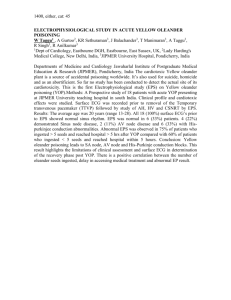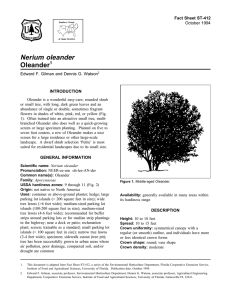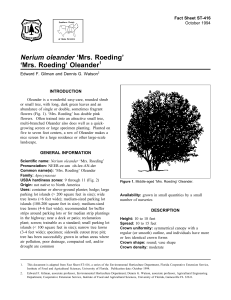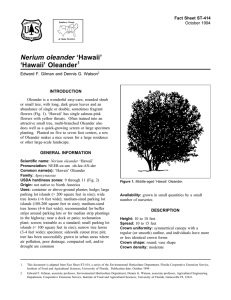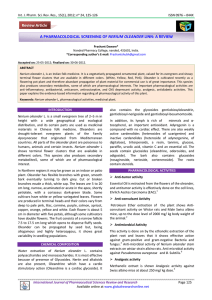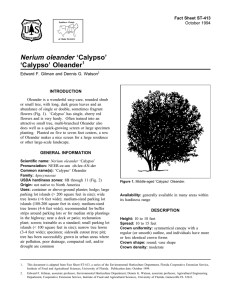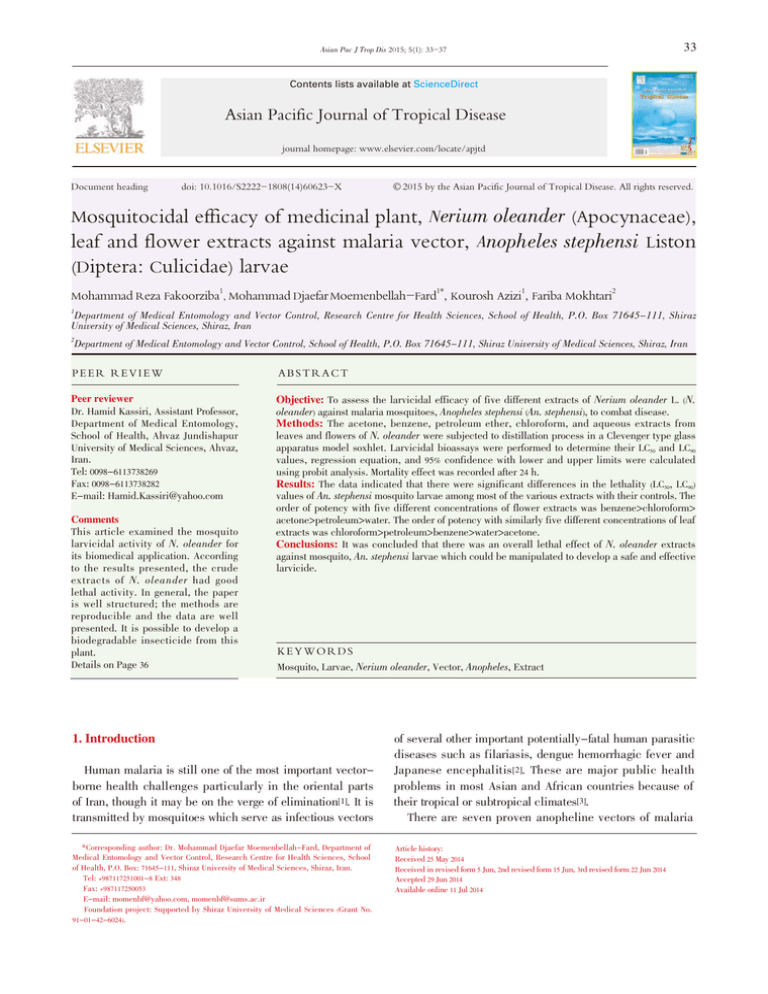
Asian Pac J Trop Dis 2015; 5(1): 33-37
33
Contents lists available at ScienceDirect
Asian Pacific Journal of Tropical Disease
journal homepage: www.elsevier.com/locate/apjtd
Document heading
doi: 10.1016/S2222-1808(14)60623-X
襃 2015
by the Asian Pacific Journal of Tropical Disease. All rights reserved.
efficacy of medicinal plant, Nerium oleander (Apocynaceae),
leaf and flower extracts against malaria vector, Anopheles stephensi Liston
(Diptera: Culicidae) larvae
Mosquitocidal
1
1*
Mohammad Reza Fakoorziba , Mohammad Djaefar Moemenbellah-Fard
, Kourosh Azizi1, Fariba Mokhtari2
Department of Medical Entomology and Vector Control, Research Centre for Health Sciences, School of Health, P.O. Box 71645-111, Shiraz
University of Medical Sciences, Shiraz, Iran
1
Department of Medical Entomology and Vector Control, School of Health, P.O. Box 71645-111, Shiraz University of Medical Sciences, Shiraz, Iran
2
PEER REVIEW
ABSTRACT
Peer reviewer
Dr. Hamid Kassiri, Assistant Professor,
Department of Medical Entomology,
School of Health, Ahvaz Jundishapur
University of Medical Sciences, Ahvaz,
Iran.
Tel: 0098-6113738269
Fax: 0098-6113738282
E-mail: Hamid.Kassiri@yahoo.com
Objective: To assess the larvicidal efficacy of five different extracts of Nerium oleander L. (N.
oleander) against malaria mosquitoes, Anopheles stephensi (An. stephensi), to combat disease.
Methods: The acetone, benzene, petroleum ether, chloroform, and aqueous extracts from
leaves and flowers of N. oleander were subjected to distillation process in a Clevenger type glass
apparatus model soxhlet. Larvicidal bioassays were performed to determine their LC50 and LC90
values, regression equation, and 95% confidence with lower and upper limits were calculated
using probit analysis. Mortality effect was recorded after 24 h.
Results: The data indicated that there were significant differences in the lethality (LC50, LC90)
values of An. stephensi mosquito larvae among most of the various extracts with their controls. The
order of potency with five different concentrations of flower extracts was benzene>chloroform>
acetone>petroleum>water. The order of potency with similarly five different concentrations of leaf
extracts was chloroform>petroleum>benzene>water>acetone.
Conclusions: It was concluded that there was an overall lethal effect of N. oleander extracts
against mosquito, An. stephensi larvae which could be manipulated to develop a safe and effective
larvicide.
Comments
This article examined the mosquito
larvicidal activity of N. oleander for
its biomedical application. According
to the results presented, the crude
extracts of N. oleander had good
lethal activity. In general, the paper
is well structured; the methods are
reproducible and the data are well
presented. It is possible to develop a
biodegradable insecticide from this
plant.
Details on Page 36
KEYWORDS
Mosquito, Larvae, Nerium oleander, Vector, Anopheles, Extract
1. Introduction
Human malaria is still one of the most important vectorborne health challenges particularly in the oriental parts
of Iran, though it may be on the verge of elimination[1]. It is
transmitted by mosquitoes which serve as infectious vectors
*Corresponding author: Dr. Mohammad Djaefar Moemenbellah-Fard, Department of
Medical Entomology and Vector Control, Research Centre for Health Sciences, School
of Health, P.O. Box: 71645-111, Shiraz University of Medical Sciences, Shiraz, Iran.
Tel: +987117251001-8 Ext: 348
Fax: +987117250053
E-mail: momenbf@yahoo.com, momenbf@sums.ac.ir
Foundation project: Supported by Shiraz University of Medical Sciences (Grant No.
91-01-42-6024).
of several other important potentially-fatal human parasitic
diseases such as filariasis, dengue hemorrhagic fever and
Japanese encephalitis[2]. These are major public health
problems in most Asian and African countries because of
their tropical or subtropical climates[3].
There are seven proven anopheline vectors of malaria
Article history:
Received 25 May 2014
Received in revised form 5 Jun, 2nd revised form 15 Jun, 3rd revised form 22 Jun 2014
Accepted 29 Jun 2014
Available online 11 Jul 2014
34
Mohammad Reza Fakoorziba et al./Asian Pac J Trop Dis 2015; 5(1): 33-37
including Anopheles culicifacies, Anopheles stephensi (Diptera:
C ulicidae ) ( An. stephensi ) , Anopheles dthali, Anopheles
fluviatilis, Anopheles sacharovi, Anopheles superpictus,
and Anopheles pulcherrimus in Iran[4]. The frequent use of
insecticidal sprays and other chemical compounds to kill
mosquitoes leads to a destabilization of the ecosystem and
will affect the natural environment. Insecticide resistance
is also increasingly becoming a challenge in many vector
control activities. T o evade these problems, a major
emphasis has been made on the use of natural plantbased larvicides which could be a safe alternative to the
synthetic insecticides[5]. Research is currently going on to
discover environmentally-friendly products, such as the use
of biological compounds, to eliminate the larval and adult
mosquitoes. One such method is to use medicinal plants
extracts against mosquito larvae in water bodies, since
killing of the larvae is the weakest link in the life cycle of
the malaria vector. It will terminate the natural life cycle
and thus prevent further breeding of the mosquitoes which
transmit malaria.
An. stephensi, an oriental malaria vector, is widely
distributed in Indo-Persian region from India, Pakistan and
Iran, to countries around the Persian Gulf. It occurs widely in
the southern Iranian provinces of Kermanshah, Khuzestan,
Fars, Kerman, Hormozgan, and Sistan-Baluchistan[6].
Nerium oleander L . ( G entianales: A pocynaceae ) ( N.
oleander) is an evergreen small shrub of 2-5 m in height with
a wide geographical and ecological distribution[7]. Oleanders
are drought tolerant plants in the family Apocynaceae that
is originated from the Mediterranean basin[8]. N. oleander
displays white or pink terminal flower clusters which are
visible on different branches[9]. All parts of the oleander
plant are poisonous to humans and animals with repellent
effect against certain insects[10-12]. But it is also proved to
have various medicinal activities such as antibacterial[1315], anti-inflammatory and antinociceptive[16,17], cytotoxic[18],
antidiabetic[19], immunomodulatory[20], cardiotonic[21], and
neuroprotective effects[22]. There are chemical compounds
like oleandrin in the leaves of this plant.
Given these considerations, this plant is now being studied
for its uses in medicine. In recent years, much effort has
been focused on the exploration of bioactive chemical
compounds from native plants for mosquito control in
Iran. So, the purpose of the present study was to evaluate
the larvicidal potential of N. oleander on malaria vector
mosquito, An. stephensi, under laboratory conditions.
2. Materials and methods
2.1. Plant identification and preparation
In May 2011, the aerial parts including leaves and flowers
of N. oleander (Figure 1) during blossoming stage were
collected from the capital city of Ilam (54°13’N, 31°12’E, with
an altitude of about 1 427 m above sea level), Ilam province,
on the western border of Iran with Iraq. The mean annual
temperature is 23 °C and its mean annual precipitation
rate is 620 mm. A voucher specimen was deposited in the
herbarium of Eram botanical garden of Shiraz University,
Shiraz, Iran. The fresh leaves and flowers were washed
with distilled water, shade-dried at ambient temperature,
finely powdered using an electrical stainless steel blender
and stored in an air-tight container until further use.
Morphological features of N. oleander were determined using
Flora Iranica key[23] and a stereomicroscope.
Figure 1. Habitus of N. oleander plant showing the leaves and pink flowers on
some branches.
2.2. Mosquito rearing
Early fourth-instar larvae of An. stephensi were used for
bioassay tests. The laboratory bred An. stephensi (type strain,
at Kazerun in Fars province) was reared in the insectarium
at the department of medical entomology, Shiraz University
of Medical Sciences (SUMS), and maintained at 27 °C with a
photoperiod of 10 h light and 14 h dark at 75%-85% relative
humidity. About 10% yeast suspension was used as food
source ad libitum.
2.3. Isolation of plant extracts
The leaves and flowers were dried for 2 weeks in the
shade at ambient temperature (27-35 °C days time). Airdried plant material from the aerial parts of N. oleander
was subjected to hydro-distillation for 3 h in a Clevenger
type glass apparatus model Soxhlet with acetone, benzene,
distilled-water, petroleum, or chloroform solvents. For each
sample, 50 g of the plant materials (leaves or flowers) were
separately extracted each time with 400 mL of solvent. After
extraction, the resultant samples were dried on a rotary
vacuum evaporator to delete water and kept in amber vial at
4 °C prior to the biological assays. The sample yielded 4% of
solvent extracts and 18% of aqueous extract on a dry weight
basis of 100 g.
35
Mohammad Reza Fakoorziba et al./Asian Pac J Trop Dis 2015; 5(1): 33-37
2.4. Larvicidal bioassay
Ten different plant extracts were subjected to bioassay
against 25 larvae in each replicate. The third and fourth
stage larvae of An. stephensi (type strain) were kept in 500 mL
glass beaker containing 249 mL of distilled water with 1.0 mL
of different desired plant extracts derived from flowers or
leaves with a concentration of 0.25, 0.5, 0.75, 1.0, 1.5, 1.75, 2.0,
2.5, 3.0 and 4.0 g/L. Four replicates for each concentration
were set up. A control was also set up with 1 . 0 m L of
acetone or aqueous solvent in 249 mL of distilled water.
The control mortality was corrected by Abbott’s formula[24]
and the values for LC50, LC90, regression equation, and 95%
confidence interval with fiducially lower and upper limits
were calculated by using probit analysis[25].
3. Results
Table 1
Lethal concentration values for various leaf extracts of N. oleander against
fourth stage larval mosquitoes of An. stephensi.
Acetone
LC50 and LC90
(g/L)
1.865 (6.723)
2.149 (6.949)
Chloroform 0.588 (1.747)
Petroleum
Benzene
Aqueous
Acetone
LC90 (g/L)
2.221(5.600 3)
Regression
95% Confidence limit
Slope依SE
LCL:LC50 (LC90) UCL:LC50 (LC90)
equation
Y=3.190 6X+3.894 3 2.020 8 (4.518 9) 2.460 4 (7.919 3) 3.190 6依0.408 1
1.094 (5.933)
Y=1.745 0X+4.931 0 0.901 0 (4.195 0) 1.297 0 (10.387 0) 1.745 4依0.227 7
1.946 (3.986)
Y=4.126 1X+3.803 6 1.137 0 (2.811 0) 2.745 0 (14.268 0) 4.126 1依0.636 0
Chloroform 0.925 (3.211) Y=2.370 6X+5.080 2 0.789 0 (2.468 0) 1.054 0 (5.020 0) 2.370 6依0.338 1
Petroleum
Benzene
0.551 (1.374)
Y=3.229 8X+5.835 8 0.494 0 (1.151 0)
0.609 0 (1.784 0) 3.229 8依0.362 3
LCL: lower confidence limit; UCL: upper confidence limit.
T he LC 50 and LC 90 indices under all concentrations
indicated that the benzene extract of flower and the
chloroform extract of leaves had the most effective
mortalities on larval mosquitoes. Benzene extracts were
more effective in killing of mosquito larvae than the other
extracts (Figure 2). The aqueous flower extract caused about
50% less mortality on An. stephensi larvae than the aqueous
leaf extract.
1.651 (3.477)
1.772 (3.415)
Regression
95% Confidence limit
LCL:LC50 (LC90) UCL:LC50 (LC90)
equation
Y=3.016X+4.376 8
1.601(5.204)
2.124 (10.155)
Y=2.514 5X+4.164 4 1.936 (5.166) 2.432 (11.633)
Y=2.709 9X+5.624 3 0.514 (1.440)
0.665 (2.289)
Y=3.964 4X+4.135 8 1.518 (2.966)
1.790 (4.477)
Y=4.499 3X+3.881 1 1.647 (2.963)
1.910 (4.254)
LCL: lower confidence limit; UCL: upper confidence limit,
Slope依SE
2.301 6依0.300 0
2.514 5依0.358 9
2.709 9依0.271 7
3.964 4依0.501 9
4.499 3依0.538 0
Flower extracts, on the other hand, using benzene and
aqueous solvents gave the most and the least larvicidal
effects, respectively. The order of potency with four different
concentrations of flower extracts was as follows: benzene>
chloroform>acetone>petroleum>water (Table 2).
7
Concentration (g/L)
mosquito larvae among most of the various extracts of N.
oleander with their controls (P<0.05). It was shown that
there was a significant difference between the LC50 of larval
mosquitoes using aqueous extract in relation to the other
extracts (P<0.05).
Leaf extracts of N. oleander had the most and the least
anti-larval effects with chloroform and acetone solvents,
respectively. There was also a significant difference between
the four different concentrations used (P<0.05), so that
the LC50 of mosquito larvae at 2.5 g/L herbal extract was
more effective than that at 0.5 g/L, indicating the higher
concentration gave a bigger value for mortality (Table 1). The
order of potency with similarly four different concentrations
of leaf extracts was as follows: chloroform>petroleum>
benzene>aqueous>acetone.
Aqueous
LC50 and
Extract
8
The current data indicated that there were significant
differences in the LC50 and LC90 values of An. stephensi
Extract
Table 2
Lethal concentration values for various flower extracts of N. oleander against
fourth stage larval mosquitoes of An. stephensi.
6
5
4
3
2
1
0
Aqueous
LC50 (Flower)
Acetone
LC50 (Leaf)
Chloroform
Extract
Petroleum
LC90 (Flower)
Bendzene
LC90 (Leaf)
Figure 2. The relative lethality of different extracts from flowers and leaves of
N. oleander plant on An. stephensi larvae.
4. Discussion
Arthropods transmit various diverse pathogenic agents
with immense public health importance in Iran[26-29]. It was
found that there was an overall lethal effect of N. oleander
extracts against larval mosquitoes, An. stephensi, in Iran.
Compared to the other extracts, the aqueous extract clearly
revealed a weaker lethal activity against larval mosquitoes.
The chloroform and benzene extracts exhibited marked
lethal activity against these premature insects. Even though
the number of reports on aromatic plants used in different
countries for their larval mosquitocidal activities continues
to increase, to the best of our knowledge, no studies have
been published on the lethal activity of N. oleander against
the malaria vector mosquito larvae, An. stephensi, in Iran.
Our research focused solely on LC50 and LC90 activity
with instant effectiveness after the exposure, of which the
highest was within 1 h of exposure to petroleum extract.
Effectiveness is generally likely to be the most real factor
in the search for noble herbal compounds. Apart from the
direct impact of these compounds on lethality of mosquito
36
Mohammad Reza Fakoorziba et al./Asian Pac J Trop Dis 2015; 5(1): 33-37
larvae, secondary impacts may culminate in reduced
fecundity and eggs delivery[30].
The Nerium plant is native to Iran. It is thus conceivable
to search for native means of combating larval mosquitoes.
Some recent studies have addressed the phytochemical
composition of N. oleander leaves having larvicidal effect
against a few vector mosquitoes[8,31]. The various extracts of
N. oleander plant exhibited high larvicidal activity against
different stages particularly the fourth larval stage of An.
stephensi mosquitoes, which is corroborated by other studies
carried out elsewhere[12,32,33]. This plant appears to have
active ingredients which could kill the mosquito larvae
effectively. This fact may be used as a solution for the long
lasting problem with mosquitoes in the developing countries
without incurring any environmental damage[31]. This idea
has been put forward by global agencies long ago[34].
It was thus concluded that there was a significant lethal
effect of N. oleander leaf extracts containing chemicals
like oleandrin against larval mosquitoes, An. stephensi, in
southern parts of Iran.
Conflict of interest statement
We declare that we have no conflict of interest.
Acknowledgements
The authors appreciate the improvements to this article
that were meticulously proposed by the peer reviewers. The
present paper was extracted from the results of an approved
MSc student thesis (Grant No. 91-01-42-6024 Dated 16 May
2012) conducted by the fourth author, Ms. Fariba Mokhtari.
It was financially supported by Shiraz University of Medical
Sciences. We are also indebted to Ms. M. Amin for her
assistance in the lab and insectarium. Thanks go to the
vice-chancellor for Research and Technology at SUMS, for
permitting the use of facilities at the university.
Comments
Background
H uman malaria caused by the protozoan parasites,
Plasmodium, and transmitted by the infectious bites
of female mosquitoes, Anopheles, remains a formidable
vector-borne health challenge particularly in the oriental
parts of Iran. The potential use of medicinal plant extracts
on mosquito larvae in aquatic habitats implicates a safe,
effective and biodegradable alternative to the synthetic
insecticides. The present study examined the larvicidal
activity of N. oleander plant on malaria vector, An. stephensi.
Research frontiers
This research is conducted to evaluate the larvicidal
activity of N. oleander plant. Bioactive chemical compounds
in the leaf and flower of this plant are effective against
specific target insects and are decomposable.
Related reports
Many papers have reported the efficacy of plant extracts
against mosquito larvae such as Raveen et al. (2014), Roni et
al. (2013), Kumar et al. (2012) and Sedaghat et al. (2011) who
reported on the mosquitocidal efficacy of plant extracts
against different larval species.
Innovations & breakthroughs
This research showed that the benzene extract of flowers
and the chloroform extract of leaves of N. oleander plant
had the most effective mortalities on larval mosquitoes. This
finding is highly important in the field of pharmacology
for the production of novel drugs to control the vectors of
malaria.
Applications
It is valuable to find the use of commonly distributed
plant (N. oleander) throughout the Southwest Asia, including
I ran, for extraction of novel bioactive compounds with
unique significance and medical application. T hus, it
has been shown here that the benzene extract of flowers
and the chloroform extract of leaves of N. oleander are
pharmacologically important.
Peer review
This article examined the mosquito larvicidal activity of
N. oleander for its biomedical application. According to the
results presented, the crude extracts of N. oleander had good
lethal activity. In general, the paper is well structured; the
methods are reproducible and the data are well presented. It
is possible to develop a biodegradable insecticide from this
plant.
References
[1] Moemenbellah-Fard MD, Saleh V, Banafshi O, Dabaghmanesh T.
Malaria elimination trend from a hypo-endemic unstable active
focus in southern Iran: predisposing climatic factors. Pathog Glob
Health 2012; 106: 358-365.
[2] F akoorziba MR , V ijayan VA . V ariation in morphological
characters of Culex tritaeniorhynchus (Diptera: Culicidae), a
Mohammad Reza Fakoorziba et al./Asian Pac J Trop Dis 2015; 5(1): 33-37
Japanese encephalitis vector at Mysore. J Commun Dis 2003; 35:
206-213.
[3] Service M. Medical entomology for students. 5th ed. Cambridge,
UK: Cambridge University Press; 2012.
[4] Sedaghat M, Dehkordi AS, Abai M, Khanavi M, Mohtarami F,
Abadi YS, et al. Larvicidal activity of essential oils of Apiaceae
plants against malaria vector, Anopheles stephensi. Iran J
Arthropod Borne Dis 2011; 5: 51-59.
[5] Ghosh A, Chowdhury N, Chandra G. Plant extracts as potential
mosquito larvicides. Indian J Med Res 2012; 135: 581-598.
[6] S edaghat MM , H arbach RE . A n annotated checklist of the
Anopheles mosquitoes (Diptera: Culicidae) in Iran. J Vector Ecol
2005; 30: 272-276.
[7] Fu L, Zhang S, Li N, Wang J, Zhao M, Sakai J, et al. Three new
triterpenes from Nerium oleander and biological of the isolated
compounds. J Nat Prod 2005; 68: 198-206.
[8] Gupta V, Mittal P. Phytochemical and pharmacological potential
of Nerium oleander: a review. Int J Pharm Sci Res 2010; 1: 21-27.
[9] R aveen R , K amakshi KT , D eepa M , A rivoli S , T ennyson S .
Larvicidal activity of Nerium oleander L. (Apocynaceae) flower
extracts against Culex quinquefasciatus Say (Diptera: Culicidae).
Int J Mosq Res 2014; 1: 38-42.
[10] Singh C, Pandey DN, Shukla S. Pesticidal effect of Euphorbia,
Nerium and Calotropis latex on some larvae of crop damaging
pests. Int J Pharm Pharm Sci 2012; 4(4): 256-260.
[11] Nazemi RJ, Moharamipour S. Repellency of Nerium oleander L.,
Lavandulla officinalis L. and Ferula assafoetida L. extracts on
Tribolium castaneum (Herbst). Iran J Med Arom Plants 2008; 23:
443-452.
[12] Bagari M, Bouhaimi A, Ghaout S, Chihrane J. The toxic effects
of Nerium oleander on larvae of the desert locust Schistocerca
gregaria (Forksal 1775) (Orthoptera, Acrididae). Zool Baetica 2013;
24: 193-203.
[13] Roni M, Murugan K, Panneerselvam C, Subramaniam J, Hwang
JS. Evaluation of leaf aqueous extract and synthesized silver
nanoparticles using Nerium oleander against Anopheles stephensi
(Diptera: Culicidae). Parasitol Res 2013; 112: 981-990.
[14] Huq MM, Jabbar A, Rashid MA, Hasan CM. A novel antibacterial
and cardiac steroid from the roots of Nerium oleander. Fitoterapia
1999; 70: 5-9.
[15] Derwich E, Benziane Z, Boukir A. Antibacterial activity and
chemical composition of the essential oil from flowers of Nerium
oleander. Electron J Environ Agric Food Chem 2010; 9(6): 10741084.
[16] Suganya RS, Priya K, Roxy SB. Phytochemical screening and
antibacterial activity from Nerium oleander and evaluate their
plant mediated nanoparticle synthesis. Int Res J Pharm 2012; 3:
285-288.
[17] Erdremoglu N, Küpeli E, Yeşilada E. Anti-inflammatory and
antinociceptive activity assessment of plants used as remedy in
Turkish folk medicine. J Ethnopharmacol 2003; 89: 123-129.
[18] Kumar S, Anand GR. Evaluation of anti-inflammatory activity of
Nerium oleander. Pharmacia 2010; 1: 33-36.
[19] E l S awi NM , G eweely NS , Q usti S , M ohamed M , K amel A .
C ytotoxicity and antimicrobial activity of Nerium oleander
37
extracts. J Appl Anim Res 2010; 37: 25-31.
[20] M wafy SN , Y assin MM . A ntidiabetic activity evaluation of
glimepiride and Nerium oleander extract on insulin, glucose
levels and some liver enzymes activities in experimental diabetic
rat model. Pak J Biol Sci 2011; 14: 984-990.
[21] Al-Farwachi MI. In vivo and in vitro immunomodulatory activities
of Nerium oleander aqueous leaf extract in rabbits. J Anim Vet
Adv 2007; 14: 1047-1050.
[22] A dome RO , G achihi JW , O negi B , T amale J , A pio SO . T he
cardiotonic effect of the crude ethanolic extract of Nerium
oleander in the isolated guinea pig hearts. Afr Health Sci 2003; 3:
77-82.
[23] Dunn DE, He DN, Yang P, Johansen M, Newman RA, Lo DC. In
vitro and in vivo neuroprotective activity of the cardiac glycoside
oleandrin from Nerium oleander in brain slice-based stroke
models. J Neurochem 2011; 119: 805-814.
[24] Rechinger KH. Flora Iranica. Graz: Akademische Druck-und
Verlagsanstalt; 1982.
[25] A bbott WS . A method of computing the effectiveness of an
insecticide. J Econ Entomol 1925; 18: 265-267.
[26] F inney DJ . Probit analysis. 3 rd ed. C ambridge, E ngland:
Cambridge University Press; 1971.
[27] Fakoorziba MR, Neghab M, Alipour H, Moemenbellah-Fard
MD. Tick-borne Crimean-Congo haemorrhagic fever in Fars
province, Southern Iran: epidemiologic characteristics and vector
surveillance. Pak J Biol Sci 2006; 9: 2681-2684.
[28] Fakoorziba MR, Golmohammadi P, Moradzadeh R, MoemenbellahFard MD, Azizi K, Davari B, et al. Reverse transcription PCRbased detection of Crimean-Congo haemorrhagic fever virus
isolated from ticks of domestic ruminants in Kurdistan province
of Iran. Vector Borne Zoonotic Dis 2012; 12: 794-799.
[29] F akoorziba MR , B aseri A , E ghbal F , R ezaee S , A zizi K ,
Moemenbellah-Fard MD. Post-earthquake outbreak of cutaneous
leishmaniasis in a rural region of southern Iran. Ann Trop Med
Parasitol 2011; 105(3): 217-224.
[30] Moemenbellah-Fard MD, Fakoorziba MR, Azizi K, MohebbiNodezh M. Carbamate insecticides resistance monitoring of adult
male German cockroaches, Blattella germanica (L.), in Southern
Iran. J Health Sci Surveillance Sys 2013; 1: 41-47.
[31] Pavela R. Larvicidal activities of some Euro-Asiatic plants against
Culex quinquefasciatus Say (Diptera: Culicidae). J Biopesticides
2008; 1: 81-85.
[32] Lokesh R, Leonard Barnabas E, Madhuri P, Saurav K, Sundar K.
Larvicidal activity of Trigonella foenum and Nerium oleander
leaves against mosquito larvae found in Vellore city, India. Curr
Res J Biol Sci 2010; 2: 154-160.
[33] Roni M, Murugan K, Christina Mary S, Sivapriyajothi S, Suganya
NA, Dinesh D, et al. Ovicidal and adulticidal activity of Nerium
oleander extract against Anopheles stephensi Liston (Insecta:
Diptera: Culicidae). Int J Innov Res 2013; 1: 107-111.
[34] W orld H ealth O rganization. G uidelines for laboratory and
field testing of mosquito larvicides. G eneva: W orld H ealth
Organization; 2005. [Online] Available from: http://whqlibdoc.
who.int/hq/2005/WHO_CDS_WHOPES_GCDPP_2005.13.pdf?ua=1
[Accessed on 25th May, 2014]

